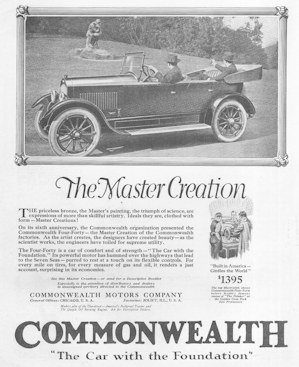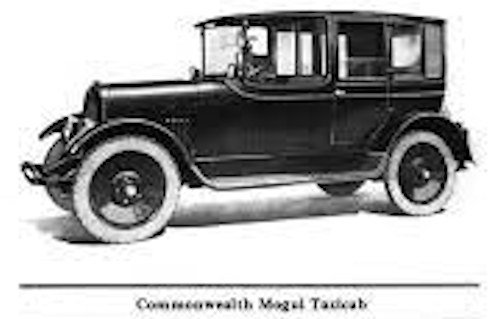Commonwealth Motors Corporation History

The Commonwealth Motors Corporation is a former American car manufacturer, from 1915 to 1922, The brand name was Commonwealth.
History
Commonwealth Motors Corporation built quality automobiles and also manufactured taxis of the brand Mogul. The company had roots that date back to the early days of the automobile. As early as 1900 had William Andrew foam in Baltimore built an automobile called the foam. From 1908 to 1909 produced with De Schaum Motor Syndicate Company in Buffalo New York a high wheeler, which were offered under the brand names Seven Little Buffaloes and De Schaum and were moderately successful.
A move of the company to Hornell in Steuben County, New York, and its renaming as De Schaum-Hornell Motor Car Company, was followed by no further production. The De Foam Motor Car Company, and just 10 cars built De Schaum in November 1912.
His successor was Randall A. Palmer, led to the reorganization as Palmer Motor Car Company. The Suburban was abandoned after only 15 more vehicles had been built. Under the brand name Palmer there were a few prototypes, which were influenced by the Suburban. Only a few months after its founding, it merged with the Partin Manufacturing Company in Chicago. This resulted in a further reorganization that took place in June 1913 and to Partin Palmer Motor Car Company, headquartered in Rochelle (Illinois) and Chicago. Brand names were Partin, Partin-Palmer and Pioneer for a cycle car. Charles C. Darnall, most recently Sales Director at Partin-Palmer, gained control of the company.
The Pioneer was manufactured in a dedicated subsidiary, the American Manufacturing Company, based in Chicago. The Pioneer was the last of a total of nine automobile projects of this name in the US between 1896 and 1914 - and one of only four that actually led to at least one road vehicle. He was also one of the few really reputable constructions in this by hobbyists, dominated market segment. The Pioneer was a typical representative of its genus. Made in lightweight construction with an air-cooled V2 engine, friction gear, Belt drive, tight track and a roadster body that was so narrow that the passenger seat had to be placed a little lower and a little farther back, so that the driver could enjoy some elbow room, the vehicle cost a comparatively moderate US $ 385. His problems were, that it first appeared when the cyclecar boom collapsed as quickly as it had flared up two years earlier, and that, secondly, the parent was in big financial trouble. So, the Pioneer held only a few months in the market.
The production of the cycle car was discontinued at the end of 1914, but only from 1917 until then continued to sell as Partin-Palmer sold cars under the new brand name Commonwealth on the market. The "new" Commonwealth Four was broadly similar to the old Partin-Palmer Model 32 with a 110 inch to 112-inch extended chassis, but the price soared from $ 595 (Model 32 Roadster) to $ 695. (Model 32 5-Passenger Touring) for $ 895 each for the Commonwealth Four. The headquarters were moved in 1919 to Joliet in Illinois. The chassis was made by Parish & Bingham in heavy duty stainless steel. The extra reinforced side rails were over 12 cm thick and there were 6 cross members. Oversized insulation mats were used between chassis and body to prevent squeaking noise from the outset. To the parts of the hood to hold together, more rivets were used than any other car. The engines were initially purchased by Lycoming and from about the middle of 1920 by Herschell-Spillman . Except in model year 1919, when a Lycoming six-cylinder engine was offered, all Commonwealth automobiles had four-cylinder engines. At times, the four-cylinder Roadster was sold with an included tent as American Traveller.

Some Commonwealth was used by taxi drivers in Chicago for its sturdy construction. End of 1919, the manufacturer responded by offering on the chassis of his four-cylinder car also taxi versions. The bodywork supplier was the Joliet-based Lomberg Auto Body Manufacturing Company. These taxis were only built until the end of 1920. The mogul was made for the Checker Cab Company, a taxi driver in Chicago, Illinois. Although not directly related to the later Checker Motors Corporation, their company and product name is likely to be traced back to this same taxi operator. whether Checker Cab acquired the model exclusively is not proven. However, it is largely the same as the first Checker taxi, which was also built in Commonwealth facilities.
In late 1921, Leland F. Goodspeed joined the Commonwealth as Chief Engineer. As vice president of the Barley Motor Car Company and designer of their flagship, the Roamer, he enjoyed an excellent reputation in the industry. With a Roamer he had personally set several world records for production cars in Daytona Beach. At Commonwealth he wanted to realize his project of a new luxury brand, which should bear his name. The Goodspeed was designed as a sporty six-cylinder model. While for the Roamer but still a purchased four-cylinder engine Rochester-Duesenberg had been used, Goodspeed had developed this engine itself. This had dual ignition and for smoother running and pumping valves instead of the usual valves with bucket tappets. The chassis, a solid ladder frame with integrated seats for the bumpers, which were often optional at the time, had a wheelbase of 3150 mm. In fact, at the beginning of the year, test drives with a prototype were undertaken. A second car was even shown at the Motor Show in Chicago in January 1922. It had an open body as touring fenders, fashionable treadplates instead of through-going tread boards, dark-painted chromium spoke wheels with white tires, and a windshield whose upper part could be exposed to the front. The proposed retail price should be US $ 5400, which would have the car in the upper luxury area. The manufacturer spoke of a planned, limited production. But that did not happen.

The company's Ultra-4 Forty 1919-1920 also refers to a Quayle- branded Commonwealth four-cylinder engine that could be used with any "liquid oil". He made 25/35 hp and came out without electric ignition, carburettor or fuel pump. This points to a heavy oil engine that is structurally similar to the diesel engine. The Lanz Bulldog single cylinder from 1921 also worked on this principle. 1920 was, a conventional-looking farm tractor called the Thorobred with thin spoked wheels in front and massive steel wheels behind. Accordingly, he had steel tires with patented self-cleaning and throughout Timken ball bearings, which was understood as a quality feature. The noted "oil-burning" engine naturally indicates an in-house Quayle. The power is noted at 18 bhp (13.4 kW) on the belt.
A severe economic crisis hit the automotive industry hard in 1920-1921 following the First World War. In particular, the numerous small and smallest manufacturers suffered significantly, many had to close. Commonwealth Motors had an additional problem because of the numerous brand names and name changes also by predecessor companies (Partin, Palmer, Partin-Palmer, Pioneer, Commonwealth, Mogul, Goodspeed). Given the quality of the Commonwealth automobiles. The crisis had a particularly fatal effect on the taxi business; the taxi companies switched to cheap used cars, which they could adapt to their needs. Finally, ten more taxis were produced per week. Lomberg Auto Body had been taken over by the biggest creditor, Morris Markin. The company was reorganized and renamed Markin Body Corporation.
Shortly before this fate also befell Commonwealth Motors, the company was temporarily rescued by a capital injection and the aforementioned large order of the Checker Cab. In May 1922, Commonwealth and Lomberg Auto Body merged to form the Checker Cab Manufacturing Company.
Technical
-
Commonwealth Models (1915-1922)
Model
HP NACCYears
engine
Displacement
ci / cm³Power
bhp / kWWheelbase
mm / inchbody
Price
US $Model 44
19.6 HP1917-1918
4 row; sv
Herschell-Spillman192.4 / 3153
40 / 29.8
2845/112
Roadster 4 Pl.
895.-
Model 44
19.6 HP1917-1918
4 row; sv
Herschell-Spillman192.4 / 3153
40 / 29.8
2845/112
Roadster 4 Pl.
895.-
Model 44
19.6 HP1919
4 series
Herschell-Spillman192.4 / 3153
40 / 29.8
2921/115
Roadster 4 Pl.
1095.-
Model 44
19.6 HP1919
4 series
Herschell-Spillman192.4 / 3153
40 / 29.8
2921/115
Touring 5 Pl.
1095.-
Victoria Six
25.31919
6 series
Lycoming2921/115
Touring
1295.-
Mogul
21.3 HP1919-1922
4 row, sv
Buda211.6 / 3467
33.75 / 25.1 [24]
2972/117
taxi
Four-40
1920
4 series
Lycoming sv35 / 26,1
2972/117
Touring 5 Pl.
1395.-
Four-45
1921-1922
4 series
Lycoming sv35 / 26,1
2972/117
Touring 5 Pl.
1595.-
Four-45
1921-1922
4 series
Lycoming sv35 / 26,1
2972/117
Sport (Phaeton ) 4 Pl.
1785.-
Four-45
1921-1922
4 series
Lycoming sv35 / 26,1
2972/117
Sedan 5 Pl.
2465.-
Goodspeed
1922 (prototypes)
6 series
Goodspeed3150/124
various
5400.-
Production figures
model year
number of pieces
1917
213
1918
436
1919
627
1920
1828
1921
912
1922
324
Total
4340
